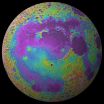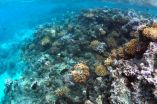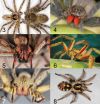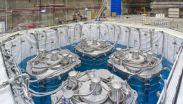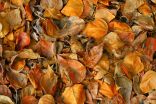(Press-News.org) New data obtained by NASA's GRAIL mission reveals that the Procellarum region on the near side of the moon — a giant basin often referred to as the "man in the moon" — likely arose not from a massive asteroid strike, but from a large plume of magma deep within the moon's interior.
The Procellarum region is a roughly circular, volcanic terrain some 1,800 miles in diameter — nearly as wide as the United States. One hypothesis suggested that it was formed by a massive impact, in which case it would have been the largest impact basin on the moon. Subsequent asteroid collisions overprinted the region with smaller — although still large — basins.
Now researchers from MIT, the Colorado School of Mines, and other institutions have created a high-resolution map of the Procellarum, and found that its border is not circular, but polygonal, composed of sharp angles that could not have been created by a massive asteroid. Instead, researchers believe that the angular outline was produced by giant tension cracks in the moon's crust as it cooled around an upwelling plume of hot material from the deep interior.
Maria Zuber, the E.A. Griswold Professor of Geophysics and also MIT's vice president for research, says that as cracks occurred, they formed a "plumbing system" in the moon's crust through which magma could meander to the surface. Magma eventually filled the region's smaller basins, creating what we see today as dark spots on the near side of the moon — features that have inspired the popular notion of a "man in the moon."
"A lot of things in science are really complicated, but I've always loved to answer simple questions," says Zuber, who is principal investigator for the GRAIL (Gravity Recovery and Interior Laboratory) mission. "How many people have looked up at the moon and wondered what produced the pattern we see — let me tell you, I've wanted to solve that one!"
Zuber and her colleagues publish their results this week in the journal Nature.
Making Less of an Impact
The team mapped the Procellarum region using data obtained by GRAIL — twin probes that orbited the moon from January to December 2012. Researchers measured the distance between the probes as they chased each other around the moon. As the leading probe passed over a region of lower density, it briefly slowed, caught by that region's gravitational pull. As the probes circled the moon, they moved in accordion fashion, the distance between them stretching and contracting in response to varying gravitational attraction due to the mass variations in the lunar interior.
From the variable distance between the probes, Zuber and her team determined the strength of gravity across the moon's surface, creating a highly detailed map, which they then used to determine where the lunar crust thickens and thins.
From this mapping, the researchers observed that the rim of the Procellarum region is composed of edges that abut at 120-degree angles. As asteroid impacts tend to produce circular or elliptical craters, Zuber says the Procellarum's angular shape could not have been caused by an impact.
Instead, the team explored an alternative scenario: Some time after the moon formed and cooled, a large plume of molten material rose from the lunar interior, around where the Procellarum region is today. The steep difference in temperature between the magma plume and the surrounding crust caused the surface to contract over time, creating a pattern of fractures that provided a conduit for molten material to rise to the surface.
To test the hypothesis, the researchers modeled the region's gravitational signal if it were to contain volcanic intrusions — magma that seeped up to just beneath the moon's surface and, over time, cooled and crystallized. The resulting simulation matched the gravity signal recorded by GRAIL, supporting the idea that the Procellarum was caused by a magma plume, and not an asteroid.
"How such a plume arose remains a mystery," Zuber says. "It could be due to radioactive decay of heat-producing elements in the deep interior. Or, conceivably, a very early large impact triggered the plume. But in the latter case, all evidence for such an impact has been completely erased. People who thought that all this volcanism was related to a gigantic impact need to go back and think some more about that."
INFORMATION:
Written by Jennifer Chu, MIT News Office
Related Links
The moon's face doesn't tell its whole story
http://newsoffice.mit.edu/2013/moon%E2%80%99s-face-doesn%E2%80%99t-tell-its-whole-story
An answer to a lunar mystery: Why is the moon's gravity so uneven?
http://newsoffice.mit.edu/2013/an-answer-to-why-lunar-gravity-is-so-uneven-0530
GRAIL data reveals battered lunar history
http://newsoffice.mit.edu/2012/grail-reveals-a-battered-lunar-history-1205
Solving the mystery of the 'man in the moon'
MIT researchers find that a volcanic plume, not an asteroid, likely created the moon's largest basin
2014-10-01
ELSE PRESS RELEASES FROM THIS DATE:
Origin of moon's 'ocean of storms' revealed
2014-10-01
PROVIDENCE, R.I. [Brown University] — Oceanus Procellarum, a vast dark patch visible on the western edge of the Moon's near side, has long been a source of mystery for planetary scientists. Some have suggested that the "ocean of storms" is part of a giant basin formed by an asteroid impact early in the Moon's history. But new research published today in Nature deals a pretty big blow to the impact theory.
The new study, based on data from NASA's GRAIL mission, found a series of linear gravitational anomalies forming a giant rectangle, nearly 1,600 miles across, running ...
Researchers develop novel gene/cell therapy approach for lung disease
2014-10-01
CINCINNATI – Researchers developed a new type of cell transplantation to treat mice mimicking a rare lung disease that one day could be used to treat this and other human lung diseases caused by dysfunctional immune cells.
Scientists at Cincinnati Children's Hospital Medical Center report their findings in a study posted online Oct. 1 by Nature. In the study, the authors used macrophages, a type of immune cell that helps collect and remove used molecules and cell debris from the body.
They transplanted either normal or gene-corrected macrophages into the respiratory ...
New frontier in error-correcting codes
2014-10-01
CAMBRIDGE, Mass--Error-correcting codes are one of the glories of the information age: They're what guarantee the flawless transmission of digital information over the airwaves or through copper wire, even in the presence of the corrupting influences that engineers call "noise."
But classical error-correcting codes work best with large chunks of data: The bigger the chunk, the higher the rate at which it can be transmitted error-free. In the Internet age, however, distributed computing is becoming more and more common, with devices repeatedly exchanging small chunks of ...
Coral reef winners and losers
2014-10-01
Contrary to the popular research-based assumption that the world's coral reefs are doomed, a new longitudinal study from UC Santa Barbara's National Center for Ecological Analysis and Synthesis (NCEAS) paints a brighter picture of how corals may fare in the future.
An NCEAS working group reports that there will be winners and losers among coral species facing increasing natural and human-caused stressors. However, its experts demonstrate that a subset of the present coral fauna will likely populate the world's oceans as water temperatures continue to rise. The findings ...
Proving 'group selection'
2014-10-01
PITTSBURGH—The notion of "group selection"—that members of social species exhibit individual behavioral traits that render a population more or less fit for survival—has been bandied about in evolutionary biology since Darwin. The essence of the argument against the theory is that it's a "fuzzy" concept without the precision of gene-based selection.
Jonathan Pruitt, assistant professor of behavioral ecology in the University of Pittsburgh's Department of Biological Sciences within the Kenneth P. Dietrich School of Arts and Sciences, has published a paper today in the ...
New study provides key to identifying spiders in international cargo
2014-10-01
Spiders found in international cargo brought into North America are sometimes submitted to arachnologists for identification. Often, these spiders are presumed to be of medical importance because of their size or similarity to spiders that are known to be venomous.
In 2006, after witnessing multiple episodes where harmless spiders were mistaken for toxic ones, Dr. Richard Vetter, an arachnologist at the University of California, asked other arachnologists to provide data on specimens they found in international cargo that had been submitted to them for identification. ...
Scientists aim to give botox a safer facelift
2014-10-01
New insights into botulinum neurotoxins and their interactions with cells are moving scientists ever closer to safer forms of Botox and a better understanding of the dangerous disease known as botulism. By comparing all known structures of botulinum neurotoxins, researchers writing in the Cell Press journal Trends in Biochemical Sciences on October 1st suggest new ways to improve the safety and efficacy of Botox injections.
"If we know from high-resolution structures how botulinum neurotoxins interact with their receptors, we can design inhibitors or specific antibodies ...
Journal supplement examines innovative strategies for healthy aging
2014-10-01
WASHINGTON— The Society for Public Health Education (SOPHE) proudly announces the publication of a Health Education & Behavior (HE&B) supplement devoted to the latest research and practice to promote healthy aging. The October 2014 supplement, "Fostering Engagement and Independence: Opportunities and Challenges for an Aging Society," contains a dozen peer-reviewed articles on innovative behavioral and psycho-social approaches to improve the health of the nation's fastest growing cohort - older adults.
Together the articles describe promising advances in research directed ...
Hide and seek: Sterile neutrinos remain elusive
2014-10-01
BEIJING; BERKELEY, CA; and UPTON, NY - The Daya Bay Collaboration, an international group of scientists studying the subtle transformations of subatomic particles called neutrinos, is publishing its first results on the search for a so-called sterile neutrino, a possible new type of neutrino beyond the three known neutrino "flavors," or types. The existence of this elusive particle, if proven, would have a profound impact on our understanding of the universe, and could impact the design of future neutrino experiments. The new results, appearing in the journal Physical Review ...
New approach can predict impact of climate change on species that can't get out of the way
2014-10-01
CUMBERLAND, MD (October 1, 2014)--When scientists talk about the consequences of climate change, it can mean more than how we human beings will be impacted by higher temperatures, rising seas and serious storms. Plants and trees are also feeling the change, but they can't move out of the way. Researchers at the University of Maryland Center for Environmental Science and University of Vermont have developed a new tool to overcome a major challenge of predicting how organisms may respond to climate change.
"When climate changes, organisms have three choices: migrate, adapt, ...
LAST 30 PRESS RELEASES:
Tracing the quick synthesis of an industrially important catalyst
New software sheds light on cancer’s hidden genetic networks
UT Health San Antonio awarded $3 million in CPRIT grants to bolster cancer research and prevention efforts in South Texas
Third symposium spotlights global challenge of new contaminants in China’s fight against pollution
From straw to soil harmony: International team reveals how biochar supercharges carbon-smart farming
Myeloma: How AI is redrawing the map of cancer care
Manhattan E. Charurat, Ph.D., MHS invested as the Homer and Martha Gudelsky Distinguished Professor in Medicine at the University of Maryland School of Medicine
Insilico Medicine’s Pharma.AI Q4 Winter Launch Recap: Revolutionizing drug discovery with cutting-edge AI innovations, accelerating the path to pharmaceutical superintelligence
Nanoplastics have diet-dependent impacts on digestive system health
Brain neuron death occurs throughout life and increases with age, a natural human protein drug may halt neuron death in Alzheimer’s disease
SPIE and CLP announce the recipients of the 2025 Advanced Photonics Young Innovator Award
Lessons from the Caldor Fire’s Christmas Valley ‘Miracle’
Ant societies rose by trading individual protection for collective power
Research reveals how ancient viral DNA shapes early embryonic development
A molecular gatekeeper that controls protein synthesis
New ‘cloaking device’ concept to shield sensitive tech from magnetic fields
Researchers show impact of mountain building and climate change on alpine biodiversity
Study models the transition from Neanderthals to modern humans in Europe
University of Phoenix College of Doctoral Studies releases white paper on AI-driven skilling to reduce burnout and restore worker autonomy
AIs fail at the game of visual “telephone”
The levers for a sustainable food system
Potential changes in US homelessness by ending federal support for housing first programs
Vulnerability of large language models to prompt injection when providing medical advice
Researchers develop new system for high-energy-density, long-life, multi-electron transfer bromine-based flow batteries
Ending federal support for housing first programs could increase U.S. homelessness by 5% in one year, new JAMA study finds
New research uncovers molecular ‘safety switch’ shielding cancers from immune attack
Bacteria resisting viral infection can still sink carbon to ocean floor
Younger biological age may increase depression risk in older women during COVID-19
Bharat Innovates 2026 National Basecamp Showcases India’s Most Promising Deep-Tech Ventures
Here’s what determines whether your income level rises or falls
[Press-News.org] Solving the mystery of the 'man in the moon'MIT researchers find that a volcanic plume, not an asteroid, likely created the moon's largest basin
